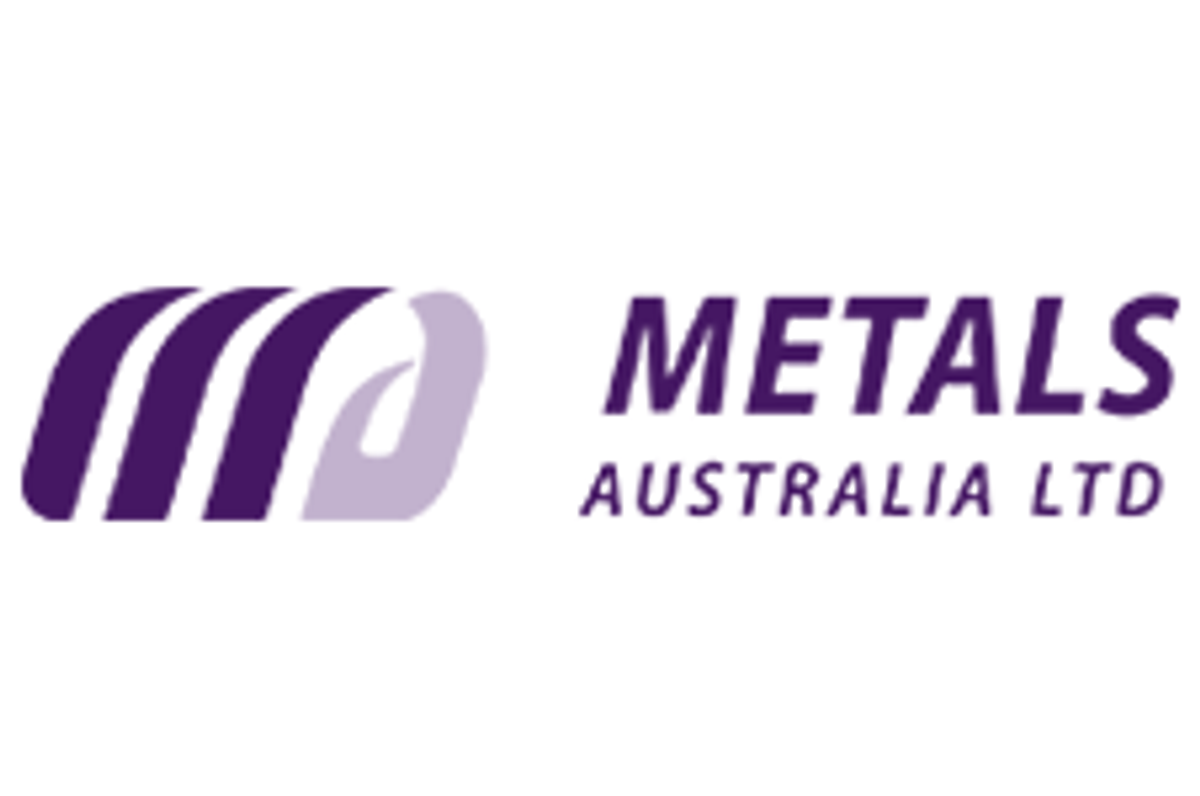
October 08, 2024
- 4,500m drilling program to test priority targets on prospective greenstone-splay faults along strike from major gold deposits in one of Australia’s most prolific gold provinces
Metals Australia Ltd (ASX: MLS) (“Metals Australia” or “the Company”) is pleased to announce that drilling is set to commence to test priority targets identified at the Company’s Big Bell North tenements (EL51/2058 and EL51/2059) in Western Australia’s world-class Murchison Gold Province. The tenements lie within the regional structural corridor which hosts major gold deposits including the Meekatharra and Mt Magnet gold mining centres (Figure 2).
HIGHLIGHTS
- Up to 4,500m aircore drilling program set to commence testing priority greenstone-splay, fault-hosted gold targets interpreted under cover at Big Bell North, along strike from the 5Moz Big Bell Mine and Garden Gully Projects in Western Australia’s world-class Murchison Gold Province.
- The Big Bell North tenements cover an extensive 337km2 area where little previous exploration has been carried out due to extensive regional soil cover and the historic lack of recognition of greenstone lithologies.
- Interpretation of recently completed aeromagnetic and gravity surveys has defined greenstone-splay fault priority drilling targets on both the eastern and western zones of the Big Bell North tenements.
- Drilling will initially focus on the Eastern Zone over a 9km north-south trend interpreted to be a faulted greenstone corridor (interpreted to be 700-1,400m wide) splaying from the regional scale Chunderloo Shear Zone. This setting is identical to the Garden Gully highgrade gold project, immediately along strike to the northeast, held by Ora Gold Ltd (OAU).
- The Eastern Zone drill targets have been further refined to align magnetic lows from the aeromagnetic survey with strong positive gravity survey responses, indicative of denser greenstones (dominated by prospective mafic rocks) in the interpreted shear zone. Shear zones associated with magnetic lows commonly coincide with quartz veining/alteration2.
- Soil sampling is also underway across the Western Zone target. Subject to results, a drilling program will follow to test bedrock targets for buried gold deposits at the Western Zone, where shallower cover exists.
- Anomalous gold results in the aircore drilling programs will be followed up with deeper RC drilling to test across the gold-anomalous structures.

Metals Australia Ltd CEO Paul Ferguson commented:
“The drilling program we are set to commence at our highly prospective Big Bell North gold project in Western Australia’s prolific Murchison Gold Province is the latest step in the Company’s aggressive push to unlock value from our suite of gold and critical mineral projects, which are all located in wellestablished mining regions in Australia and Canada.”
Our Big Bell North project, where there has been no modern-day exploration, has advanced rapidly during 2024 on the back of a methodical, phased exploration approach from our geological team. This started with an extensive fixed wing aeromagnetic survey covering over 5,200-line km which yielded two interpreted shear zones of significance.
We followed this up with detailed gravity survey work, which revealed the likelihood of greenstones within the shear zones. This is significant because gold mineralisation within the Murchison domain is often concentrated within such greenstone belts and is structurally controlled, thus enhancing the potential of the targets we are now set to drill.
In addition to Big Bell North, we continue to advance plans for an extensive soil survey and follow-on drilling program at the Warrego East copper-gold project in the Northern Territory, which is on track to commence later this year, ahead of the wet season, once permitting and land access arrangements are finalised.
We are also awaiting results and interpretation from two other recently completed exploration programs at Warrambie in the Pilbara, where our aircore drilling program has been completed; and our Corvette River project in Quebec’s James Bay region in Canada, where assay results from the phase one field program are imminent. Exploration at Corvette River is extensively focused on gold, silver, base metals (Cu-Pb-Zn) and lithium.
At our flagship Lac Carheil high-grade flake graphite project in Quebec, positive dialogue continues as we seek to build alignment on the project’s benefits with all stakeholders. Our significant cash reserves leave us well-placed to accelerate our various exploration programs as we continue striving to unlock the true value of our suite of projects in Australia and Canada.”
Click here for the full ASX Release
This article includes content from Metals Australia, licensed for the purpose of publishing on Investing News Australia. This article does not constitute financial product advice. It is your responsibility to perform proper due diligence before acting upon any information provided here. Please refer to our full disclaimer here.
MLS:AU

Sign up to get your FREE
Metals Australia Investor Kit
and hear about exciting investment opportunities.
- Corporate info
- Insights
- Growth strategies
- Upcoming projects
GET YOUR FREE INVESTOR KIT
The Conversation (0)
02 July
Metals Australia
Investor Insight
Metals Australia offers investors exposure to a rapidly advancing, high-grade graphite development project in Quebec with near-term growth catalysts, backed by strong government support, battery-grade test results, and a diversified portfolio of critical, precious and base minerals assets in tier-1 jurisdictions.
Overview
Metals Australia (ASX:MLS) is a mineral exploration company with a high-quality portfolio of advanced battery minerals and metals projects in tier-1 mining jurisdictions of Western Australia and Canada. The portfolio comprises two critical minerals projects in Quebec, Canada – the Lac Carheil flake graphite project and the Corvette River gold, silver and base metals project. The Australian portfolio comprises two projects: Warrego East (copper-gold) in Tennant Creek, Northern Territory, and Manindi (vanadium-titanium, zinc) in Western Australia.
The push for net zero targets and the call from policymakers to transition to cleaner energy has intensified the focus on electric vehicles (EVs) and battery storage. EV automakers and battery manufacturers rely on essential materials such as graphite and metals, including lithium, nickel, copper and cobalt, to manufacture the batteries that are used in these vehicles and storage batteries generally. This has driven carmakers and battery manufacturers to partner with battery material suppliers under direct off-take agreements. Further, some automakers/battery manufacturers are buying equity stakes in miners, involving them directly in financing decisions for the development of mining projects. This is encouraging for companies such as Metals Australia as it actively advances its projects towards development.

Graphite is a critical mineral required for the mass electrification of auto transportation.
Metals Australia is focused on progressing its flagship Lac Carheil flake graphite project in Quebec, Canada. The project is well-positioned to supply high quality graphite products, including battery-grade graphite, to the North American market – including for lithium-ion and EV battery production in the future. The company has completed a major winter drill program and is targeting a mineral resource upgrade in Q3 2025, with the updated resource to feed into the ongoing PFS and downstream studies.
Metallurgical work has demonstrated battery-grade spherical graphite (99.96 percent graphitic carbon) with high conversion efficiency and tap density. Downstream battery-grade purification and shaping test work is underway in Germany with ANZAPLAN.
Metals Australia is also advancing its gold silver and base metals exploration project at Corvette River, which is adjacent to Patriot Battery Metals’ world-class lithium project. Work to date has included mapping, trenching and sampling, with further drilling programs planned for 2025.
The company continues its exploration programs at its other Australian projects: Manindi (vanadium-titanium-magnetite) and Warrego East (copper-gold).
Company Highlights
- Metals Australia is rapidly advancing its flagship Lac Carheil graphite project in Quebec, Canada.
- The company holds a high-quality suite of exploration projects, including:
- gold, silver and base metals in Quebec
- vanadium, titanium and magnetite (VTM) in Western Australia (WA) – beside an already declared zinc-copper and silver mineral resource and copper-gold in the Northern Territory (NT)
- All projects are located in tier-1 mining jurisdictions (Canada and Australia) with world-class prospectivity and stable geopolitics.
- The company’s four key projects include: Lac Carheil (graphite); Corvette River (gold, silver and base metals); Manindi (vanadium-titanium-iron + zinc-copper-silver) in WA; Warrego East in the NT (copper-gold)
- A 9,482 meters winter drilling program was completed at Lac Carheil in early 2025, increasing total drilling to ~11,800 meters.
- The program added more than 4,000 m of graphitic carbon drill intercepts to the 840 m used to define the initial mineral resource.
- Graphite mineralisation has now been confirmed to be over 2.3 km of strike length, up from 1 km, on just one of 10 mapped trends.
- A mineral resource estimate (MRE) update is expected in Q3 2025 to expand the existing JORC 2012 mineral resource of 13.3 Mt @ 11.5 percent Cg, and to support an expanded mine plan.
- Only 6 percent of 36 km mapped graphite trends have been drilled to date.
- Battery-grade graphite testing confirmed:
- 99.96 percent Cg purity
- 65.3 percent battery anode conversion efficiency
- 0.97 kg/L tap density
- A pre-feasibility study (PFS) is progressing with Lycopodium, and ANZAPLAN is advancing downstream test work for a battery anode material (BAM) facility.
- A C$600,000 grant awarded to Lac Carheil from the Quebec government to support pilot metallurgy and downstream studies.
- Exploration also continues across the Corvette River, Manindi, Warrego East Projects.
- Metals Australia is led by a seasoned board and management team with extensive mining experience and a strong track record of project development.
Key Projects
Canada
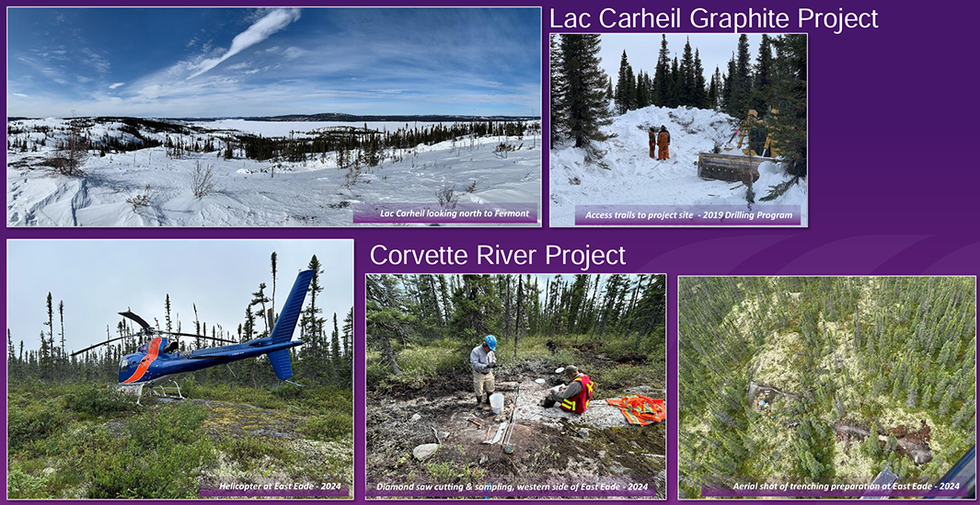
Lac Carheil Flake Graphite Project (MLS 100 percent)
The 100 percent owned Lac Carheil graphite project is located in eastern Quebec, a tier-1 mining jurisdiction with strong infrastructure and government support. The project lies near the town of Fermont and has excellent access to power and logistics, including proximity to the upgraded Highway 389, nearby hydropower infrastructure, and an expanding provincial road network.
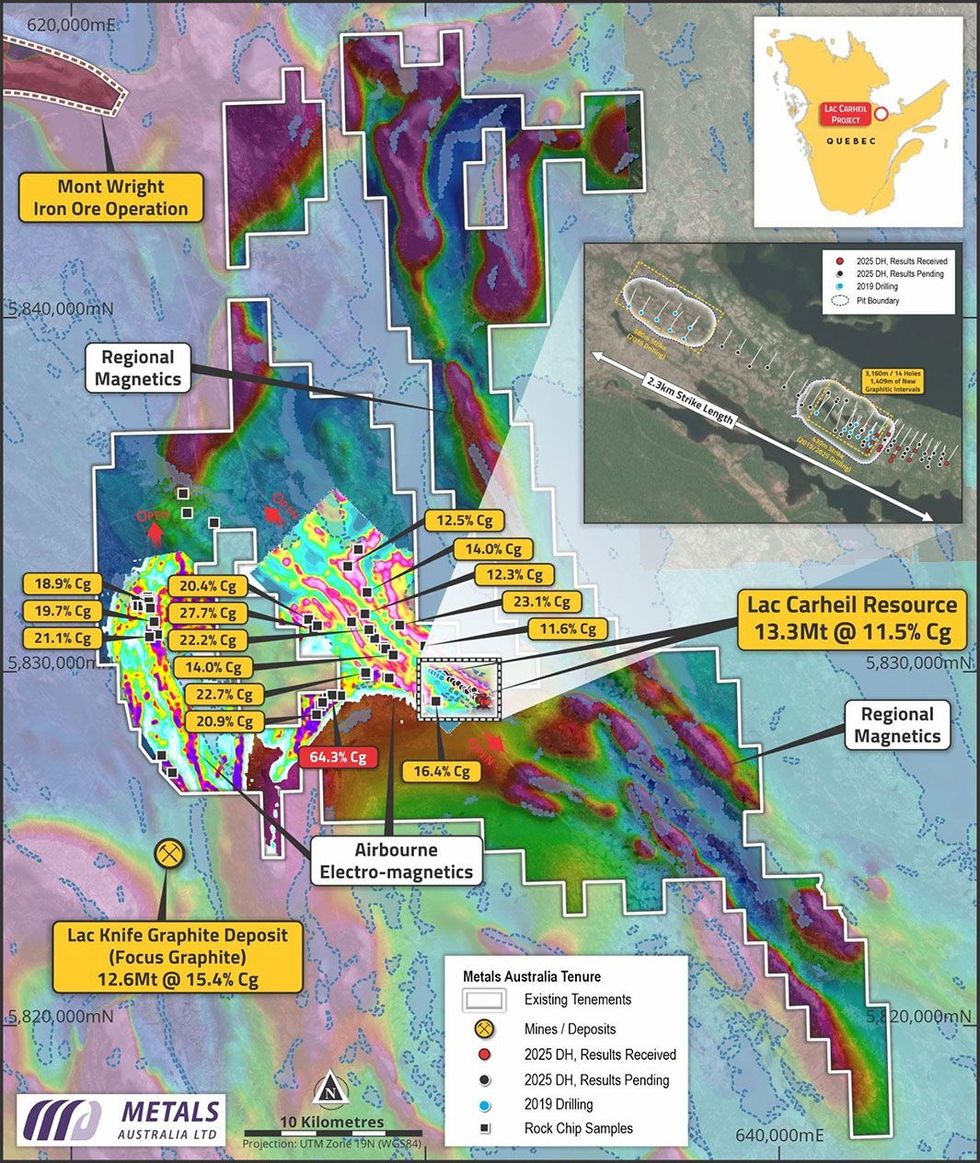
Project location, claims boundaries, graphite resource & trends, regional magnetics & sample results
The current JORC 2012 mineral resource is 13.3 Mt 11.5 percent total graphitic carbon (Cg) for 1.53 Mt of contained graphite, based on limited drilling along just 1 km of a much larger 36 km mapped trend. The resource includes an indicated resource of 9.6 Mt @ 13.1 percent Cg, and inferred resource: 3.7 Mt @ 7.3 percent Cg.
A major 9,482-meter winter diamond drilling program was completed in early 2025, increasing total project drilling to ~11,800 meters. The program defined a new southeast extension zone with multiple intersections >15 percent Cg and demonstrated graphite continuity over 2.3 km of strike length, more than double the previous extent.
The results from this drilling campaign are being incorporated into an updated mineral resource estimate, expected in Q3 2025, which will underpin the next stage of project development.
Metallurgical and battery test work has confirmed Lac Carheil’s graphite is suitable for battery-grade applications, with:
- Flotation concentrate purity of 97 percent Cg
- Spherical graphite purity of 99.96 percent Cg
- Tap density of 0.97 kg/L
- Anode conversion efficiency of 65.3 percent, exceeding global industry averages
A PFS is being led by Lycopodium Minerals Canada and is progressing in parallel with downstream battery anode (BAM) test work led by ANZAPLAN in Germany, a location study for a BAM facility, likely in Canada, and marketing and pricing assessments in collaboration with Lone Star Technical Minerals.
The project is uniquely positioned to meet North America’s surging demand for secure, domestic graphite supply, especially for EV and energy storage battery markets. It represents a strategic, high-grade, long-life source of critical material, with potential for vertical integration from mine to battery anode material.
Corvette River Gold, Silver and Base Metals Project (MLS 100 percent)
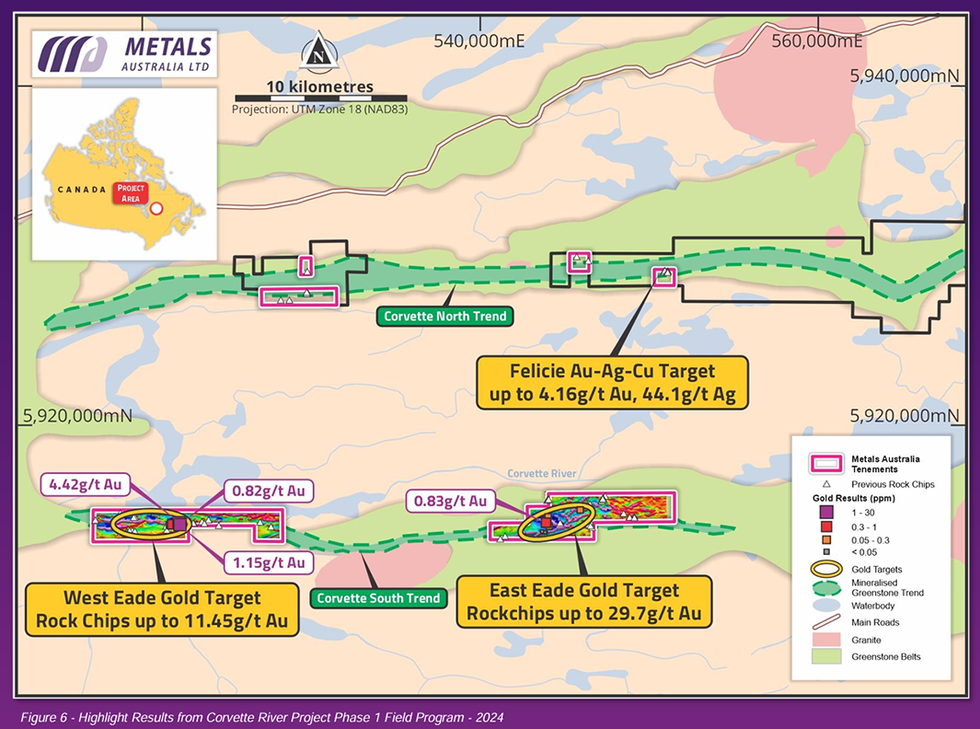
Highlights of results from Corvette River project phase 1 2024 field program
The Corvette River gold, silver and base metals project is located in Quebec’s James Bay region. Corvette River comprises multiple prospects including East Eade, West Eade and Felicie. The 2024 program confirmed high-grade gold and base metal zones, with trench samples of up to 29.7 g/t gold. Field programs are ongoing, with follow-up work planned in 2025.
Australian Projects
Manindi Project (MLS 80 percent)
Located in the Murchison District of Western Australia, the Manindi project includes a JORC-compliant zinc-copper-silver resource of 1.08 Mt at 6.52 percent zinc, 0.26 percent copper and 3.19 g/t silver. The project also hosts a high-grade vanadium-titanium-iron (Ti-V-Fe) discovery zone situated adjacent to the base metals resource.
Recent metallurgical test work from the Ti-V-Fe zone has produced two commercially attractive concentrates: a high-grade iron-vanadium product grading 66 percent Fe and 1.19 percent V₂O₅, and a titanium-iron product grading 43.8 percent TiO₂ and 32.0 percent Fe. The combined mass recovery from the two products exceeded 65 percent of the sample, and both products displayed low impurity levels and strong commercial potential. Further processing optimization is underway to enhance the TiO₂ grade.
The mineralised Ti-V-Fe zone remains open at depth and along strike and is hosted within a 2 km-long magnetic gabbro trend. A program of work is being finalised to support drilling to define a mineral resource within the original discovery and to test four newly identified nearby targets. These complements renewed interest in the zinc-copper-silver resource due to stronger base metal prices.
Warrego East Project (MLS 80 percent)
The Warrego East copper-gold project is located in the Tennant Creek region of the Northern Territory, near the historically significant Warrego Mine. The exploration license (E32725) is fully granted, and the mining management plan has been approved. Land access agreements have also been finalised.
Geophysical surveys have defined 11 compelling magnetic and gravity targets along a known mineralised corridor. These targets lie within a prospective structural setting that hosts several high-grade historical deposits. A field program is being prepared for execution following the wet season, alongside three additional tenement applications that aim to expand the project footprint.
Management Team
Paul Ferguson – Chief Executive Officer
A mining engineer, Paul Ferguson has over three decades of experience in the resources and energy sectors across North America, Asia and Australia. He has extensive project development and operational experience working in Canada. He has worked in oil & gas major ExxonMobil across project stages, including feasibility, design, construction, and operation. He has worked in executive level roles within Australia, including at GMA Garnet and held increasingly more senior roles with BHP (Iron Ore & Coking Coal) and then with Exxon Coal Minerals and Mobil Oil Australia during the early stages of his career.
Tanya Newby – CFO and Joint Company Secretary
Tanya Newby is a finance and governance professional with over 20 years’ experience in various corporate and commercial roles. She has a strong background in the resources sector and has provided financial advice and assistance to several publicly listed entities through exploration, project development through to the production stage. She is a member of the Institute of Chartered Accountants, member of the Governance Institute of Australia and a graduate member of the Institute of Company Directors.
Michael Muhling – Joint Company Secretary
Michael Muhling has over two decades of experience in resources, including 15 years in senior roles with ASX-listed companies. He is a fellow of CPA Australia, The Chartered Governance Institute, and the Governance Institute of Australia.
Chris Ramsay – General Manager Geology
Chris Ramsay is a geologist and project manager with over 25 years of experience in the global mining industry. He has been involved in exploration, mine development and operations for mining projects in Australasia, Southeast Asia, and parts of Africa and North America.
Board
Michael Scivolo – Non-executive Chairman
Michael Scivolo has extensive accounting and taxation experience for corporate and non-corporate entities. He was a partner/director at a CPA firm until 2011 and has since been consulting in accounting and taxation. Scivolo is on the boards of several ASX-listed mining companies, including Sabre Resources, Golden Deeps and Tennant Minerals Ltd.
Alexander Biggs – Non-executive Director
Alexander Biggs has over 20 years of experience in the mining and engineering sectors. During his career, he has been involved in various activities, including operations, consulting, finance and capital raising. He is currently the managing director of Lightning Minerals (ASX) and was previously the managing director of Critical Resources (ASX: CRR). Biggs is a member of the Australian Institute of Mining and Metallurgy and a graduate of the Western Australian School of Mines.
Rachelle Domansky – Non-executive Director
Rachelle Domansky is an ESG specialist and a consulting psychologist for businesses, governments and educational institutions in the Asia-Pacific region. In addition to Metals Australia, Domansky holds non-executive board positions at Larvotto Resources Ltd and Quebec Lithium.
Basil Conti – Non-executive Director
Basil Conti has been associated with the mining industry for over 25 years. He is a fellow of the Institute of Chartered Accountants Australia & NZ and was a partner/director of a chartered accounting firm in West Perth until 2015.
Keep reading...Show less
High-quality graphite project with accelerated development pathway and outstanding portfolio of exploration properties, highly prospective for gold and copper in the Northern Territory, vanadium, titanium, iron, zinc, copper and silver in WA – and gold, silver and base metals in addition to graphite in Quebec, Canada.
25 June
Drilling of N.T. Copper-Gold Targets Set to Begin
22 May
Thick High-Grade Graphite Drilling Results In New Zone
15 May
Manindi Ti-V-Fe Discovery Delivers High-Grade Concentrates
24 April
Quarterly Activities/Appendix 5B Cash Flow Report
09 April
Successful completion of Lac Carheil drilling program
4h
International Lithium Corp.
Investor Insight
International Lithium offers investors exposure to the growing critical metals sector through its advanced-stage Raleigh Lake lithium-rubidium project in Ontario, early-stage copper-cobalt exploration at Firesteel in Ontario, and strategic focus on Southern Africa, all supported by strong infrastructure and a seasoned leadership team.
With strategic divestments, a robust financial position, and a focused growth strategy, International Lithium is well-positioned to meet the rising demand for lithium and other critical metals
Overview
International Lithium (TSXV:ILC,OTC:ILHMF,FRA:IAH,OTCQB:ILHMF) is a Canada-based mineral exploration company focused on the discovery and development of lithium and other critical metals essential for the transition to a cleaner, greener planet. With a portfolio of projects located in mining-friendly jurisdictions, the company’s primary objective is to build shareholder value by advancing its key assets towards production while expanding its presence in emerging critical metals regions.
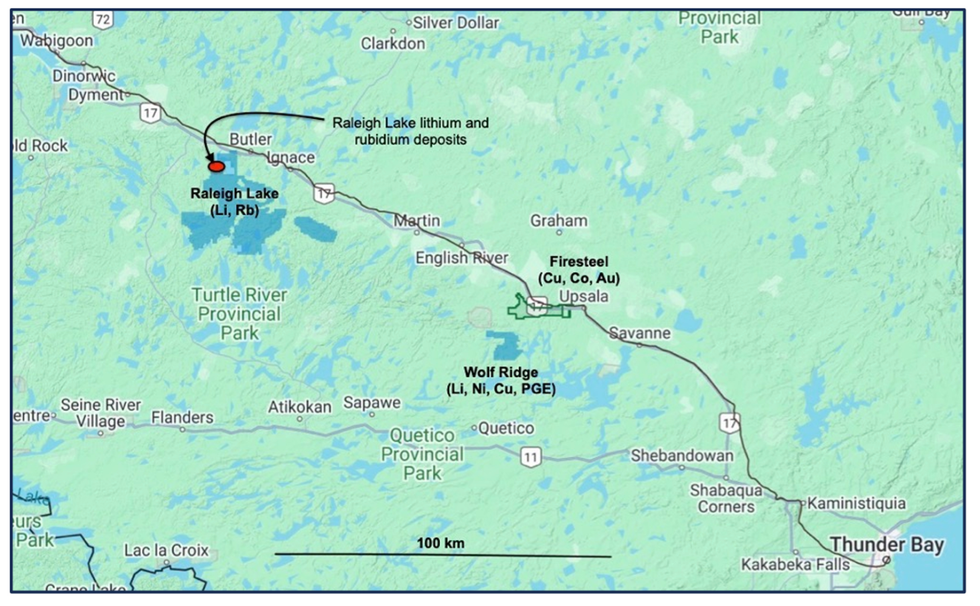
International Lithium's flagship asset is the 100 percent owned Raleigh Lake lithium and rubidium project in Ontario. A preliminary economic assessment (PEA) for the Raleigh Lake project, completed in December 2023, demonstrated strong project economics and significant resource growth potential, including an annual after-tax cash flow of C$634 million, NPV of C$342.9 million and IRR of 44.3 percent, with a nine-year mine life and project duration of 11 years. This assessment did not yet include rubidium, which represents significant additional potential pending further market analysis.
Complementing its lithium focus, the company is advancing the Firesteel copper-cobalt project in northwestern Ontario, targeting high-grade base metal mineralization to further diversify its critical metals exposure.
In addition to its Canadian projects, International Lithium is positioning for further international growth with a strategic focus on Southern Africa. It has applied for exclusive prospecting orders (EPOs) in Zimbabwe, one of the world's most prospective regions for hard rock lithium exploration.
Recent strategic divestments, including the sale of the Avalonia project stake, have strengthened ILC's financial position, enabling focused investment in its core projects.
The company is led by an experienced management team with a strong technical background in mineral exploration, project development and corporate finance. Supported by access to established infrastructure, a commitment to sustainable development practices, and a clear strategic focus, International Lithium is well-positioned to capitalize on the increasing global demand for lithium and other essential materials critical to the clean energy transition.
Company Highlights
- International Lithium is focused on developing lithium and critical metals projects in Canada and Southern Africa, aiming to deliver shareholder value through project development, strategic partnerships and project sales.
- Raleigh Lake is ILC’s wholly owned flagship lithium-rubidium project in Ontario, Canada, with a positive PEA completed in December 2023.
- ILC holds a 90 percent interest in the Firesteel copper and cobalt project in Northwestern Ontario, with exploration permits filed and drilling programs planned.
- The company has applied for exclusive prospecting orders (EPOs) in Zimbabwe and is continuing to review further exploration opportunities in Southern Africa.
- ILC is debt-free with a robust financial position. It has monetized its non-core assets, including the sale of its stake in the Avalonia project in Ireland, resulting in a C$2.5 million payment and a 2 percent net smelter royalty.
- The company is led by an experienced management team with a proven track record in advancing mineral exploration projects.
Key Projects
Raleigh Lake
The Raleigh Lake project is ILC’s flagship asset, located approximately 25 kilometres west of Ignace, Ontario. The project covers a contiguous land package of 32,900 hectares and is 100 percent owned by the company. Raleigh Lake benefits from excellent infrastructure access, situated near the Trans-Canada Highway, a Canadian Pacific Railway line, and existing natural gas and hydroelectric infrastructure.
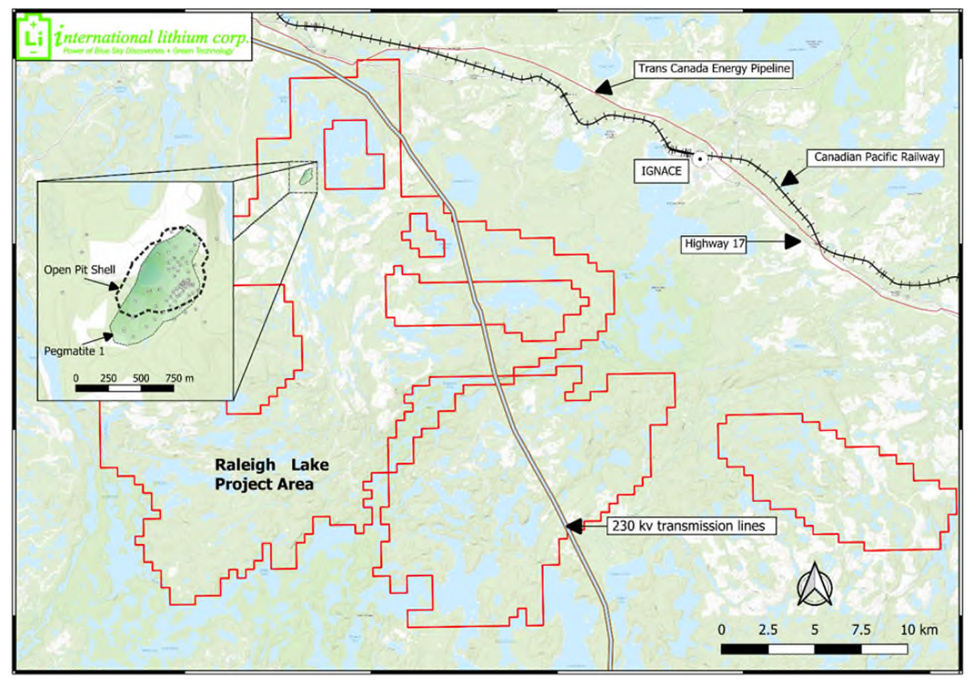
Major public infrastructure relative to the Raleigh Lake project
Raleigh Lake is notable for its dual potential to host both lithium and rubidium mineralization. The lithium is found primarily in spodumene-bearing pegmatites, while rubidium is associated with microcline-rich zones of the same lithium-cesium-tantalum pegmatite system. In 2023, International Lithium published a maiden mineral resource estimate (MRE) that delineated significant resources for both lithium and rubidium using separate cutoff criteria.
For lithium (Li₂O), the project hosts a measured and indicated resource of 5.88 Mt grading 0.79 percent Li₂O, and an inferred resource of 2.07 Mt grading 0.77 percent Li₂O, primarily within pegmatite #1. This lithium resource forms the basis of the company’s PEA, which demonstrated robust project economics with an after-tax NPV (8 percent) of C$342.9 million and an IRR of 44.3 percent.
The rubidium component, though not included in the PEA due to current market constraints, represents an additional potential value stream. The company has reported a measured and indicated resource of 133,000 tons at 6,163 ppm rubidium (0.67 percent Rb₂O) and an inferred resource of 123,000 tons at 4,224 ppm rubidium (0.46 percent Rb₂O), using a 4,000 ppm cutoff. The rubidium zones are found in association with potassic feldspar, offering a potentially recoverable byproduct pending further market and technical evaluation.
Given the project’s strong infrastructure position, mineral endowment, and defined development path, Raleigh Lake represents a compelling advanced-stage opportunity in North America's lithium supply chain. International Lithium is continuing infill and expansion drilling, environmental baseline studies, and metallurgical testing to support project advancement toward pre-feasibility.
Firesteel Project
The Firesteel project is an early-stage copper-cobalt exploration property located in northwestern Ontario, approximately 10 km west of Upsala along Highway 17. Spanning a 16-km corridor to the Firesteel River, the property lies within a geologically favorable region characterized by Archean metavolcanic and metasedimentary rocks, which are prospective for volcanogenic massive sulphide (VMS) and sedimentary copper systems.
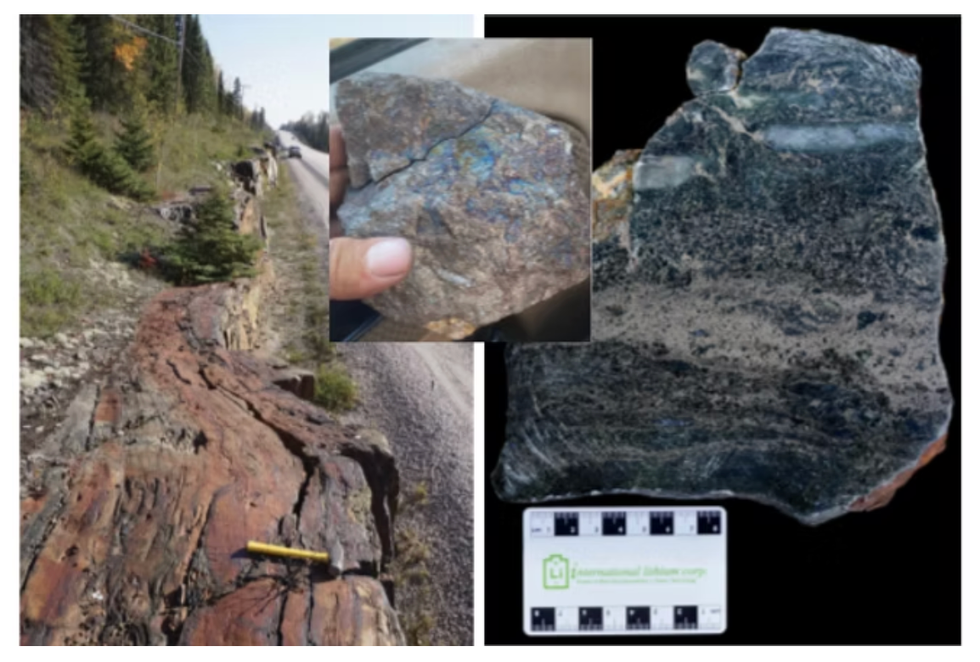
International Lithium completed the acquisition of a 90 percent interest in the Firesteel project in May 2024, aiming to diversify its critical metals portfolio beyond lithium. Historical sampling on the property has returned encouraging results, including copper assays up to 2.6 percent and cobalt values reaching 309 ppm. Notably, the "Roadside 1" occurrence features semi-massive sulphide mineralization comprising pyrite, pyrrhotite, chalcopyrite and bornite. These findings suggest the presence of a highly metamorphosed VMS or sedimentary copper system, potentially up to 20 meters wide and extending over a kilometer in length.
The project's proximity to major infrastructure, including highways and railways, coupled with its strategic location near the company's Raleigh Lake project, enhances its development potential. International Lithium plans to conduct systematic exploration, including geochemical sampling and geophysical surveys, to refine targets for future drilling campaigns.
Wolf Ridge Project
Wolf Ridge is a 5,700-hectare grassroots lithium project located 20 km southwest of Upsala and near ILC’s Firesteel copper claims. The area benefits from excellent infrastructure, including proximity to Highway 17, power, and road access.
The project was highlighted by the Ontario Geological Survey (2021–2022) for its standout lake sediment anomalies - among the highest lithium values in the region - indicating strong potential for LCT pegmatite mineralization.
Read more on page 54 of the report here.
Southern Africa Exploration Initiative
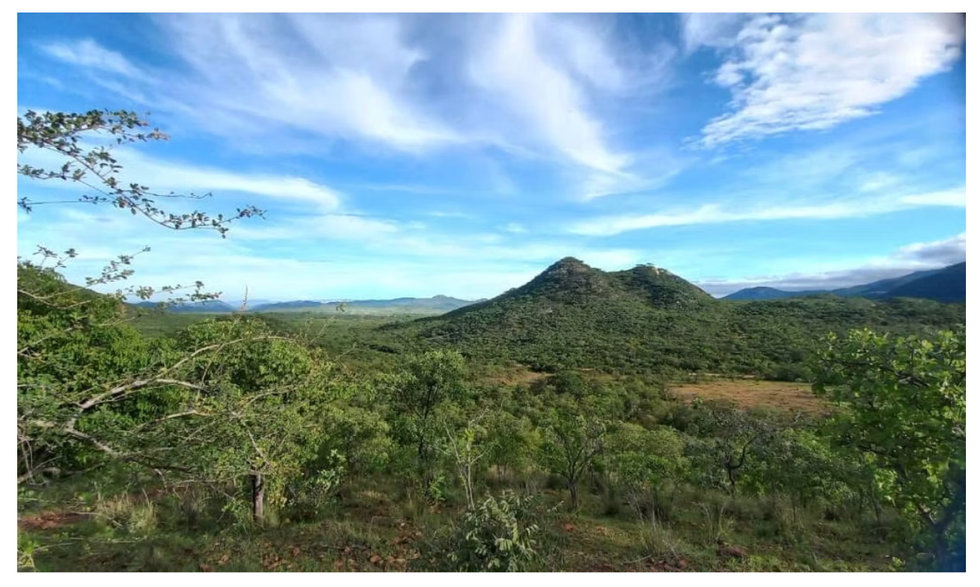
Southern Africa is recognized as a prospective region for hard rock lithium, and International Lithium’s strategic focus reflects a proactive move to establish a presence in this emerging jurisdiction.
As part of its strategy to expand its critical metals footprint, International Lithium has applied for Exclusive Prospecting Orders (EPOs) over several prospective areas in Zimbabwe. The targeted regions are known for hosting spodumene, lepidolite and petalite-bearing pegmatites, indicating potential for significant lithium resources.
Although the EPO applications are still pending approval, the company has already conducted initial due diligence, including geological reviews and desktop studies, to prioritize exploration targets once access is granted. Zimbabwe’s growing importance as a global lithium supplier, combined with favorable mining policies, offers a compelling backdrop for the company's expansion efforts. International Lithium intends to leverage its technical expertise and exploration experience to quickly evaluate and develop these opportunities upon receiving the necessary permits
Management Team
John Wisbey – Chairman and CEO
John Wisbey joined International Lithium in 2017, initially serving as deputy chairman before being appointed chairman and CEO in March 2018. Under his leadership, the company has undergone a significant transformation, including achieving 100 percent ownership of the Raleigh Lake project, divesting non-core assets, and expanding into new jurisdictions such as Zimbabwe. He founded two London AIM-listed companies: IDOX, which provides software for the UK local government; and Lombard Risk Management, which specializes in software for bank risk management and regulation. He also established CONVENDIA, a private company that specializes in software for cash flow forecasting, project valuation and M&A financial analysis. With a background in banking and financial technology entrepreneurship, Wisbey brings extensive experience in corporate leadership and strategic development. He is also the company's largest shareholder.
Maurice Brooks – Director and CFO
Maurice Brooks joined the board of ILC in 2017. He is a licensed senior statutory auditor in the UK. Since 2000, he has been a senior partner at Johnson Smith & Co. in Staines, Surrey. Before that, Brooks was a senior partner in Johnsons Chartered Accountants in the London Borough of Ealing. His commercial and investment experience includes executive directorships in manufacturing and an investment accountant role in the superannuation fund of the Western Australian state government. His early professional employment includes Ball Baker Leake LLP and LLC and Price Waterhouse Coopers-UK.
Anthony Kovacs – Director and COO
Anthony Kovacs joined the board of ILC in 2018 and has worked with the company since 2012. He has over 25 years of experience in mineral exploration and development. Before joining ILC, he held senior management roles in which he sourced and advanced iron ore and industrial minerals projects. Kovacs was involved in early-stage work at the Lac Otelnuk Iron Ore project in Quebec, Canada and the Mustavaara Vanadium Mine in Finland. Before that, Kovacs worked for Anglo American where he focused on Ni-Cu-PGE and IOCG projects. At Anglo-American, Kovacs was directly involved in several discoveries internationally. Kovacs has significant experience with industrial minerals, ferrous metals, non-ferrous metals and precious metals projects throughout the Americas, Europe and Africa.
Ross Thompson – Non-executive Director
Ross Thompson joined the board of ILC in 2017 and is the chair of the audit and remuneration committees. He is a speaker and expert in marketing behavioral science. In 1995, he founded Giftpoint Ltd. which is now one of the largest specialist promotional merchandise businesses in the UK. with offices in London and Shanghai. Giftpoint Ltd.’s clients include L’Oreal, Oracle, Ocado and Pernod Ricard among others. Thompson was president of IGC Global Promotions, one of the world’s oldest and largest global networks of premium resellers, for seven years. He is an active investor with a special interest and understanding of natural resources businesses.
Geoffrey Baker – Non-executive Director
Geoff Baker joined the board of ILC at the end of 2022 and is a member of the audit committee. He has a career in the natural resource and finance industries. He is a director of Tim Trading, a company offering consultancy services in the oil and gas industry. During his tenure as manager of Insch Black Gold Funds, Baker received the Investors' Choice Swiss Fund Manager of the Year Award. He is a co-founder of a digital collectible non fungible token CryptoChronic and of Cannastore, a pilot e-commerce website. Baker holds a bachelor's degree from the University of Windsor in Ontario.
Muhammad Memon – Corporate Secretary and Financial Controller
Muhammad Memon became corporate secretary of ILC in 2021. He has over 10 years of experience in managing finance and compliance functions of public companies in various sectors including mining exploration, investment management, real estate and technology. He assists companies with debt and equity financings, cash flow management and forecasting, legal and regulatory compliance, investor communications, stakeholder engagement and risk management. He is a member of the Chartered Professional Accountants of Canada and a fellow of the Association of Chartered Certified Accountants, United Kingdom.
Keep reading...Show less
02 July
3 Key Themes from Fastmarkets' 2025 Lithium Supply & Battery Raw Materials Event
Market volatility, Chinese control, supply chain risk mitigation and financing emerged as some of the most prevalent themes at the 2025 Fastmarket’s Lithium Supply Battery Raw Materials (LBRM) conference in Las Vegas.
The event, which is in its 17th year, drew a crowd of roughly 1000 delegates, industry experts and analysts, to discuss the current landscape and future projections of the battery materials sector.
During his opening remarks, Fastmarkets CEO Raju Daswani highlighted the growth and maturation the battery raw materials sector has experienced.
“We meet here at an extraordinary moment, the global lithium and battery materials industry is no longer a niche … It is now central to energy security, to industrial policy and to geopolitical strategy,” he said.
INN is live from Las Vegas at @Fastmarkets' Lithium Supply & Battery Raw Materials Conference!
— Resource Investing (@INN_Resource) June 25, 2025
This year's event features 1,000 attendees and 543 companies. Stay tuned for our coverage.#Lithium #BatteryMetals pic.twitter.com/yvh7CPVJm1
Daswani then went on to set the tone for the conference by posing four key questions about the current market designed to guide attendees' thinking throughout the event.
- Decoupling vs. Interdependence: Can the US and China truly decouple their lithium and battery supply chains, or will market realities force continued interdependence?
- Technology Leadership Race: Who will lead battery innovation?
- Price Sustainability: How sustainable is the current lithium price environment?
- Hidden Supply Chain Risks: What proactive steps can the industry take to address emerging risks like permitting delays, power constraints, community opposition, water limitations, talent shortages, and geopolitical instability in critical mining regions?
These questions framed the agenda for the four day event while also underscoring some of the key challenges and strategic considerations facing the global lithium and battery raw materials industry.
Robust growth projections
China’s dominance in the battery metals space was a central theme at the conference and explored via a variety of angels including supply and demand dynamics, growth projections and collaboration.
At the “Lithium Market Outlook 2025–2035: Navigating Demand Across EVs, Storage, and Strategic Sectors” presentation, Paul Lusty, head of battery raw materials at Fastmarkets painted a bullish picture for the future of lithium prices, despite the current challenges the market is facing.
#EV paradox? Paul Lusty of @Fastmarkets explains that EV sales are slower than expected, but still remain robust on a year-on-year basis.#Investing #ElectricVehicles #BatteryMetals pic.twitter.com/a2REfTQz86
— Resource Investing (@INN_Resource) June 25, 2025
We're facing headwinds, no doubt, and we're also seeing quite a lot of negative or bearish sentiment widespread in the market, and I think at times, it's amplified by voices that really overlooked the phenomenal levels of demand that we're seeing in many aspects of the market,” he said.
Although prices have floundered since 2022, the Fastmarkets team is projecting a 12 percent CAGR through to 2035.
“The long term outcome looks incredibly bullish and very compelling, the fundamentals are really still very strong, and these are anchored in some very powerful, mega trends that we see developing within the global economy.”
These trends include the urgent drive for climate change mitigation, the once in a generational shift in the global energy system, and the rise of energy intensive technologies such as artificial intelligence.
China's place in western supply
As Daswani noted in his opening remarks China’s role in the battery metal sector was a recurring topic at the conference, with several speakers and panelists weighing in.
In one of the most compelling panels “Decoding the China Playbook", panelists recounted the country’s nearly two decade long strategy to develop a robust, vertically integrated supply chain.
Iggy Tan, chairman of Lithium Universe (ASX:LU7,OTCPink:LUVSF), told the crowd China’s dominance in the battery metals sector began with a national goal of lowering vehicle emissions in the cities.
“(The) strategy was to reduce pollution in the cities, and that started the battery revolution,” he said of the nation’s switch to electric scooters and cars.
Additionally, the decision was further supported by a long term mandate.
“With the 15 year plan, government regulations, incentives, and investment started to flow according to the plan,” said Tan. “One of the downsides with Western economies is that (the government) changes every four years, whereas in China, the plan is just updated, and you can make long term investments in this area.”
.@globallithium recounts how #China overtook #Japan's #lithium battery production in the early 2000s.
— Resource Investing (@INN_Resource) June 26, 2025
"It's like Survivor — they outplayed, outwitted and outlasted," he said at @Fastmarkets' "Decoding China Playbook" panel. #Investing #Lithium pic.twitter.com/xagbLhBBAC
As Joe Lowry, president of Global Lithium (ASX:GL1,OTCPink:GBLRF) and widely considered "Mr. Lithium", added the battery supply chain in China, was further strengthened in 2003 when then president Hu Jintao selected the battery industry among his 10 Champion Industries.
Over the two decades since the Asian nation has invested heavily up and down the supply chain.
“If it was a TV show, it would be Survivor. China, outplayed, outwitted, and outlasted their competition,” said Lowry.
Financing the future
As with most cyclical commodities once lithium prices began to fall financing and investment also declined. Although the long term demand outlook is poised to benefit from battery sector expansion and energy storage system growth, the current glut in the market has created a challenge for Western companies.
This was reiterated by SC Insights Founder and Managing Director Andy Leyland, who used a colour coded chart to explain the discrepancy.
.@andyleyland1 of @SCInsightsLLC takes the stage at @Fastmarkets to present his #lithium price rainbow chart, highlighting the discrepancy in production relative to the lithium price.#Investing #BatteryMetals pic.twitter.com/UkRVlQqB3q
— Resource Investing (@INN_Resource) June 26, 2025
Leyland noted that at current low lithium prices (around US$7,000 per ton), companies are not making final investment decisions (FIDs) for new lithium projects.
Additionally over the past 12 months, hardly any FIDs have been happening in the industry. This is because at such low price levels, most projects are not financially viable.
Producers are cutting back on capital expenditures and are unable to justify new investments. The low prices make it economically challenging for companies to move forward with new lithium production projects, effectively freezing new developments in the sector.
This sentiment was echoed at the “Unlocking Funding: Bridging the Liquidity Gap and the Battery Market” panel, where YJ Lee, director and co-fund manager at Arcane Capital Advisers offered advice for junior miners.
“There's very little financing available. So the junior miners … have to really cut the corporate costs, keep that as low as possible. But the operations must go on. They must continue drilling. They must continue developing. Because the next up cycle, I believe, is just around the corner.”
Don’t forget to follow us @INN_Resource for real-time updates!
Securities Disclosure: I, Georgia Williams, hold no direct investment interest in any company mentioned in this article.
Keep reading...Show less
01 July
Expert: African Lithium Key to China's Battery Supply Chain Dominance
With the global shift to electric vehicles (EVs) accelerating, China is cementing its dominance over the lithium supply chain by pouring investment into African mines, creating a new center of gravity for the battery metal.
Speaking at the Lithium Supply Battery Raw Materials conference, Claudia Cook senior analyst at Fastmarkets offered a sweeping assessment of how China is reshaping global lithium flows and why Africa will be crucial in the next decade.
Cook laid out in detail how China’s lithium strategy is evolving. As the world’s largest EV market, China needs a consistent, low-cost supply of lithium — but its domestic production is increasingly insufficient.
“China needs growing feedstock to supply its chemical demand,” Cook explained at Fastmarkets' Lithium Supply & Battery Raw Materials event, “and Africa is of growing importance in fulfilling this gap.”
Between 2025 and 2035, lithium production across Africa is projected to increase by a staggering 127 percent, driven by new mines in Zimbabwe, Mali, Ethiopia and Namibia. Cook highlighted that against that backdrop Africa’s share of global lithium supply will surge from a small fraction today to around 80 percent by 2030.
The motivation for China is clear: the Asian nation cannot meet demand by tapping domestic sources alone. China’s hard-rock lithium supply has a growing deficit that will multiply fivefold by 2035.
“That deficit is growing and is said to be a five times increase from 2020 to 2035,” Cook said, pointing to forecasts of rising chemical demand from Chinese battery producers. As a result, Chinese firms have aggressively invested in African lithium projects, locking up supply in countries with looser regulatory controls and cheaper production costs.
In Zimbabwe and Mali, Chinese ownership of lithium mines is expected to remain significant, even if the share of Chinese-owned production in Africa declines modestly from 79 percent in 2025 to 65 percent by 2035.
“In 2025, African output is set to have 79 percent of it being China owned, and that percentage reduces down to 65 percent in 2035,” Cook stated, adding that overall output will still nearly double.
As a result, total Chinese-controlled volumes will keep rising.
Zimbabwe’s rising role in the lithium sector
Zimbabwe in particular has positioned itself at the heart of Africa’s lithium expansion.
Under its Vision 2030 program, introduced in 2018, the country is aiming to transition to an upper- to middle-income economy by building more domestic value from its minerals. As part of this framework, authorities have prioritized increasing value addition and beneficiation of raw materials as a central pillar of economic growth
Zimbabwe's 2022 ban on raw lithium ore exports, coupled with a planned 2027 ban on concentrate exports, is designed to force local upgrading and refining. Chinese-backed operators have already responded to this move, investing in midstream processing facilities that convert lithium ore into more valuable chemicals.
Cook said there were no surprises in Zimbabwe’s 2027 concentrate ban because Zimbabwe’s largest lithium projects — Arcadia and Bikita — had already planned sulfate plants late last year.
Both projects are already dominated by Chinese investors. In fact, Cook said Zimbabwe could soon become the fifth-largest producer of mined lithium globally, with Chinese interests controlling as much as 90 percent of its output.

Slide from Cook showing Zimbabwe's future lithium supply dominance in Africa.
Image via Georgia Williams.
Despite this surge, Africa’s lithium boom is hardly risk-free. Cook flagged serious challenges in transport, electricity and worker conditions in her presentation at the Fastmarkets conference.
“Local workers often also tend to be within the lower skilled jobs, and unlike the Australian mines, a lot of that work is done manually, which can mean there is an increased risk to personal safety,” she said.
Road bottlenecks and port congestion in countries like South Africa hamper exports, while rolling blackouts push some miners to build their own power infrastructure. However, China’s Belt and Road Initiative is easing some of those pain points, upgrading key transport corridors to keep African lithium flowing.
China pushing to secure lithium supply
Domestically, China is also seeing a shift in how it sources lithium.
Benchmark Mineral Intelligence data shows that brine-based production, once a major source for China, is declining relative to hard rock. By 2035, hard rock will make up the majority of Chinese feedstock.
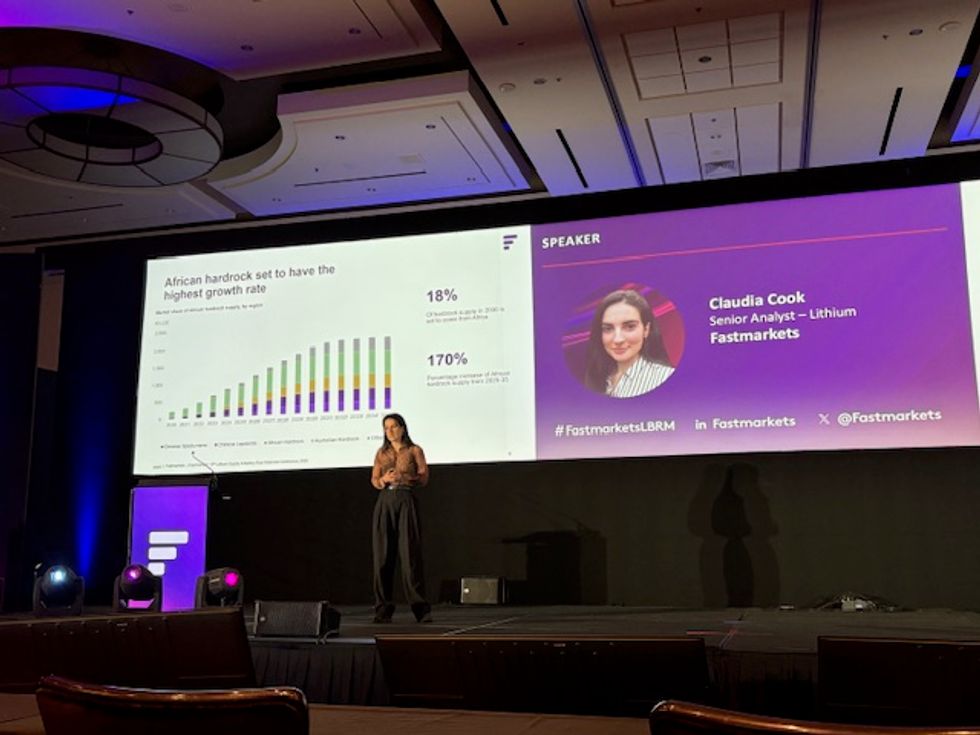
Cook speaks on stage at the Fastmarkets event.
Image via Georgia Williams.
While the reopening of CATL's (SZSE:300750,HKEX:3750) mine in Jiangxi province this year will help, Cook argued that China is still structurally dependent on Africa and other regions to fill the supply gap.
That dependence, she said, is at the heart of Beijing’s long-term lithium security push. “China is directly investing to secure supply, to get that hard-rock feedstock," she commented.
Future regional lithium players in Africa
While Zimbabwe, along with Mali, is grabbing attention now, Cook forecast that new African lithium suppliers will emerge by 2035, including Ethiopia, Namibia and the Democratic Republic of Congo.
She also noted potential future lithium supply growth from Rwanda, Nigeria and Côte d'Ivoire, even though these countries are still years away from commercial production.
This potential dominance could come with price advantages too.
African lithium projects often have lower upfront costs compared to Australia because of their lower grades and cheaper labor, even though they may face higher impurities and weaker ESG oversight.
“It also means that in terms of pricing, we see that the spodumene price that's coming out of some of these projects is typically around US$20 to US$30 lower than the spot price that you'll see quoted by Newcastle,” Cook noted.
Still, quality issues and chronic underinvestment in African infrastructure could slow progress. Cook emphasized that transport, electricity reliability and governance will determine whether Africa can live up to its lithium promise.
Don’t forget to follow us @INN_Resource for real-time updates!
Securities Disclosure: I, Giann Liguid, hold no direct investment interest in any company mentioned in this article.
Keep reading...Show less
26 June
Market Pain, Strategic Gain: Pilbara Minerals' Dale Henderson on Today's Lithium Paradox
“(Lithium) is not for the faint-hearted. It demands resilience, foresight and leadership,” said Pilbara Minerals (ASX:PLS,OTC Pink:PILBF) Managing Director and CEO Dale Henderson.
He was speaking at Fastmarkets’ Lithium Supply & Battery Raw Materials Conference, held this week in Las Vegas.
Henderson touched on three main points: current lithium market dynamics, how Pilbara Minerals is navigating the lithium landscape and his recommendations for the global lithium industry.
Lithium's strong long-term fundamentals
Henderson began by going over key numbers relevant to the lithium sector. According to the CEO, there was a 26 percent year-on-year increase in demand for electric vehicles (EVs) from 2023 to 2024.
Lithium plays a vital role in the production of EVs, as it is a key component of the batteries that power them.
Alongside that EV demand increase, mass energy storage also saw a 51 percent leap.
“I don’t think there’ll be any deniers around the long-term prospects of lithium, but it's worth reflecting on how quickly it’s changing," Henderson told the Fastmarkets audience.
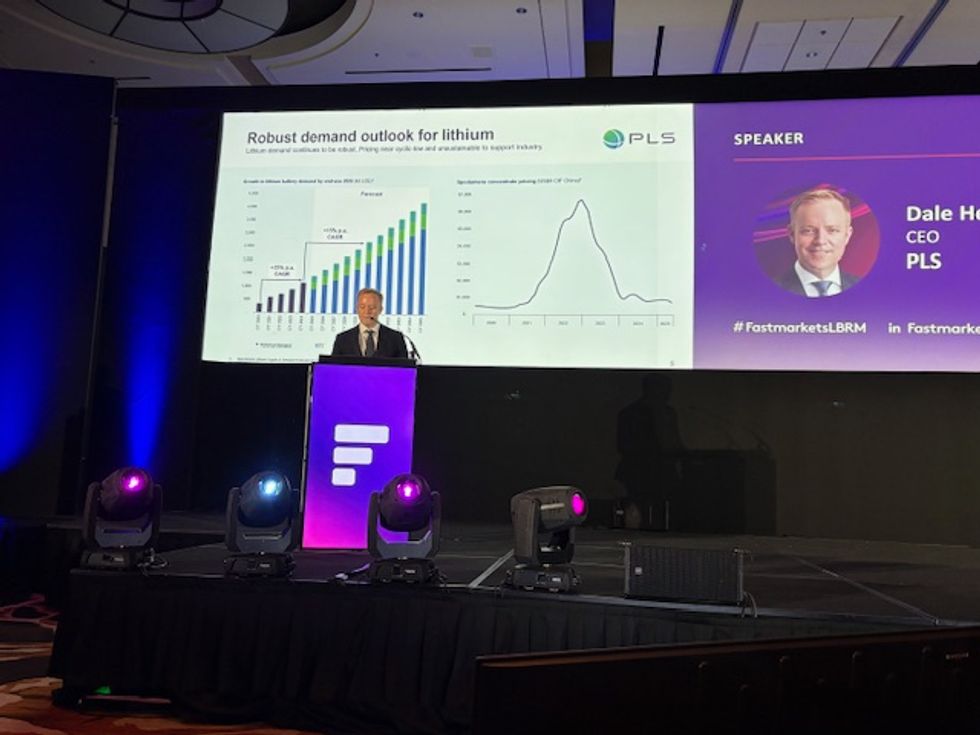
Henderson speaks on stage at the Fastmarkets event.
Image via Georgia Williams.
Looking at areas connected to lithium, Henderson mentioned solar, saying it now surpasses all power-generation technology investment combined. Solar falls under the clean energy umbrella, which receives more than $2.2 trillion in investment per year — twice the amount of investment made in fossil fuels.
“We are witnessing and (are) part of an incredible period. Technology, policy (and) consumer sentiment can continue to drive what is a structural shift towards electrification," he said. "Lithium remains at the center of this shift."
The paradox, according to Henderson, is that while scaling up is happening, prices have been cycling down.
“We’re 12 months into a period of curtailments and reset. And where we are now — we sit deep into the cost curve with price levels, of course, at unsustainable levels for many operators," he noted.
"But these cycles, or these resets, offer a fantastic reset for market, albeit they're painful.”
The Pilbara CEO emphasized that while lithium prices have fallen to “clearly unsustainable” levels, the long-term demand and strategic relevance of lithium will survive it.
“This is not a short-term trend. This is a structural transformation, and lithium remains at core.”
Pilbara Minerals' lithium strategy
Looking over to Pilbara Minerals, Henderson went over its recent achievements and future plans.
“We’re keeping our lives absolutely committed to our strategy,” he said about the company, adding that the past year was Pilbara Minerals' “most transformational year for business.”
Highlights from the period include the acquisition of Latin Resources and its flagship Salinas lithium project in Brazil, which was announced in August 2024 and closed this past February.
The CEO also discussed the company’s flagship Pilgangoora operation, which he described as a globally significant tier-one lithium asset with a mine life of 33 years. Pilgangoora is located 140 kilometers from Port Hedland in Western Australia and is one of the world’s largest hard-rock lithium operations.
Pilbara Minerals has completed two expansions, including the buildout of the world’s largest hard-rock ore-sorting plant, which aims to improve lithium recovery, increase final product quality and reduce energy consumption.
In addition to that, Henderson said Pilbara Minerals boosted its reserves by 23 percent last year.
Furthermore, the company became a lithium hydroxide producer via its partnership with POSCO Holdings (NYSE:PKX,KRX:005490), and is working on a demonstration plant for its midstream project.
In January, the Western Australian government’s Investment Attraction Fund contributed AU$15 million for work at the plant, which is a joint venture with Calix (NYSE:CALX,ASX:CXL).
Henderson said the demonstration plant is currently under construction.
Last year, Pilbara Minerals contributed approximately 8 percent to global lithium supply. The company’s cash balance currently stands at AU$1.1 billion.
Lithium industry must align for success
According to Henderson, certainty and efficient operations are everything in today’s lithium market.
“Government policy is forcing change, both in sticks and carrots, and supply chain diversification is underway, but largely the processing remains very much concentrated," he said.
Henderson highlighted coordination and collaboration as key points, saying that thriving in this environment means building deeper integration across the supply chain.
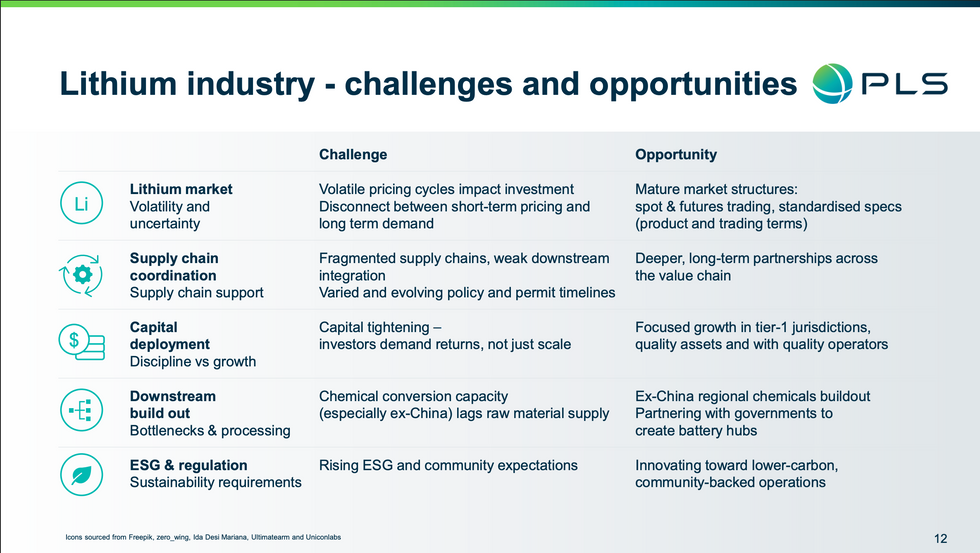
Lithium industry challenges and opportunities.
Chart via Pilbara Minerals.
He added that the lithium industry is not the first sector to grow from a small base and has yet to mature on a number of dimensions. Henderson summarized his key recommendations into four points:
- Support a central and efficient spot market trading location
- Put a trusted futures exchange in place
- Align on specifications across the lithium product site
- Align on standardized trading terms
He also presented a list of challenges and corresponding opportunities regarding the lithium market, saying that while there’s a lot of pain in the industry, it's also the time for great partnerships to be forged.
“This industry will evolve with or without our stewardship. This is a call to leadership across our group,” he concluded. “The challenge is ours. The opportunity is real. Let's build it together and turn this market pain into a strategic avenue.”
Don’t forget to follow us @INN_Resource for real-time news updates!
Securities Disclosure: I, Gabrielle de la Cruz, hold no direct investment interest in any company mentioned in this article.
Keep reading...Show less
19 June
Fastmarkets’ 2025 Lithium Conference to Tackle EV Growth, Battery Supply Chains and Market Outlook
Fastmarkets is set to host its 17th Lithium Supply and Battery Raw Materials Conference.
Scheduled to run from June 23 to 26 in Las Vegas, Nevada, the event will bring together global industry leaders to explore key topics shaping the future of the battery supply chain.
Discussions will cover lithium extraction technologies, including direct lithium extraction, as well as advances in processing, refining and recycling. More broadly, market outlooks, pricing trends and investment strategies will be analyzed alongside evolving ESG standards, policy impacts and risk management approaches.
The expansive four day agenda also encompasses innovation in battery chemistry, energy storage systems and raw materials sourcing, offering critical networking opportunities across the finance, mining and tech sectors.
Keynote speakers include Andreas Munz with BASF (OTCQX:BFFAF,FWB:BASF), Dale Henderson of PLS (ASX:PLS,OTC Pink:PILBF), Patrick Howarth with Exxon Mobil (NYSE:XOM), Peter Hannah of Albemarle (NYSE:ALB) and Sarah Maryssael with commodities giant Rio Tinto (ASX:RIO,NYSE:RIO,LSE:RIO), among many others.
Although the first half of 2025 has been volatile for lithium and other battery metals, experts believe the medium- and-long term outlook remains bright, buoyed by positive prospects for the electric vehicle (EV) sector.
According to a June Fastmarkets report, EV demand remains strong despite negative market sentiment. EV sales in China rose 30 percent year-on-year during May, with the UK and Germany leading growth in Europe.
However, US tariffs appear to be weighing on overall vehicle demand. The firm notes that American port activity recorded its steepest monthly drop since early COVID-19 lockdowns.
EV sales, energy storage growth and supply chain resilience will be some of the key topics experts and analysts discuss at the Lithium Supply and Battery Raw Materials conference.
Check back for event coverage and exclusive interviews from the Investing News Network.
Don’t forget to follow us @INN_Resource for real-time updates!
Securities Disclosure: I, Georgia Williams, hold no direct investment interest in any company mentioned in this article.
Keep reading...Show less
17 June
Inside Billionaire Gina Rinehart's Key Mining Investments
Australian billionaire Gina Rinehart has become a formidable force in the global mining industry.
After taking the helm of her father’s iron ore firm Hancock Prospecting in 1993, she embarked upon a diversification strategy that has vastly expanded her resource empire. Now Australia’s richest person, Rinehart has investments in many of the world’s most strategic commodities such as lithium, rare earths, copper, potash and natural gas.
One of those investments is Arafura Rare Earths (ASX:ARU,OTC Pink:ARAFF), which even in a low price environment for rare earths managed to secure nearly AU$1.5 billion in debt financing in mid-2024 to advance its Nolans project in the Northern Territory. With a 10 percent equity stake, Rinehart’s Hancock Prospecting is Arafura's largest shareholder.
In addition to Arafura, entrepreneur Rinehart’s investment portfolio contains other ex-China, green-transition-focused companies like Australian lithium firm Liontown Resources (ASX:LTR,OTC Pink:LINRF), as well as rare earths producers MP Materials (NYSE:MP) and Lynas Rare Earths (ASX:LYC,OTC Pink:LYSCF). Rinehart’s role in the acquisition of Azure Minerals’ Andover lithium project in Western Australia alongside lithium giant SQM (NYSE:SQM) also made headlines.
In this article
- Who is Gina Rinehart?
- How did Gina Rinehart get rich?
- What mining companies does Gina Rinehart own?
- Where does Hancock Prospecting mine iron?
- Gina Rinehart’s iron ore investments
- Gina Rinehart’s lithium investments
- Gina Rinehart’s rare earths investments
- Gina Rinehart’s copper investments
- Gina Rinehart’s oil and gas investments
- Gina Rinehart’s potash and agriculture investments
- FAQs for Gina Rinehart
Who is Gina Rinehart?
Gina Rinehart is an Australian iron ore magnate and the executive chair of Hancock Prospecting, as well as the richest person in Australia and one of the world’s richest women. Rinehart is the daughter of Australian mining mogul and Hancock Prospecting founder, the late Lang Hancock. As the current executive chair of Hancock Prospecting, Rinehart won the inaugural Lifetime Achievement Award from CEO Magazine in 2019.
Rinehart was appointed as an Officer of the Order of Australia in 2022 for her “distinguished service to the mining sector, to the community through philanthropic initiatives, and to sport as a patron.”
How did Gina Rinehart get rich?
Gina Rinehart's Hancock Prospecting acquired the Roy Hill tenements in 1993. Centering the massive project as the cornerstone of the company, Hancock Prospecting has greatly benefited from the iron ore market boom that began in the early 2000s.
Today, Roy Hill is Australia’s largest iron ore mine, producing 60 million to 70 million tonnes of iron ore per year. Success at Roy Hill has made Hancock Prospecting Australia’s most valuable private company at an estimated AU$15.6 billion.
As with many of the world’s most successful billionaires, Gina Rinehart has developed an investment strategy based on strategic partnerships as well as diversification to mitigate risk and build value. Under her leadership, Hancock Prospecting Pty Limited (HPPL) as well as the HPPL Group of companies has expanded into some of the world’s most economically important markets, such as real estate, agriculture, energy and critical metals.
For the 2024 fiscal year, Rinehart's Hancock Prospecting reported a bumper profit of AU$5.6 billion, up 10 percent from the previous year.
What mining companies does Gina Rinehart own?
Through her company Hancock Prospecting, Gina Rinehart owns interest in mining companies across many sectors, including iron ore, lithium, rare earths, copper, oil and gas, as well as potash.
While much of her investment portfolio is focused on Australia and ASX companies, Rinehart is actively strengthening the geographical diversification of her investments.
In recent years, Rinehart has made a series of key investments in mining companies, especially targeting critical metals projects in Germany, Brazil, Ecuador and the United States. These include exploration-stage firms such as Titan Minerals (ASX:TTM) and Azure Minerals as well as producers such as Atlas Iron and MP Materials.
Where does Hancock Prospecting mine iron?
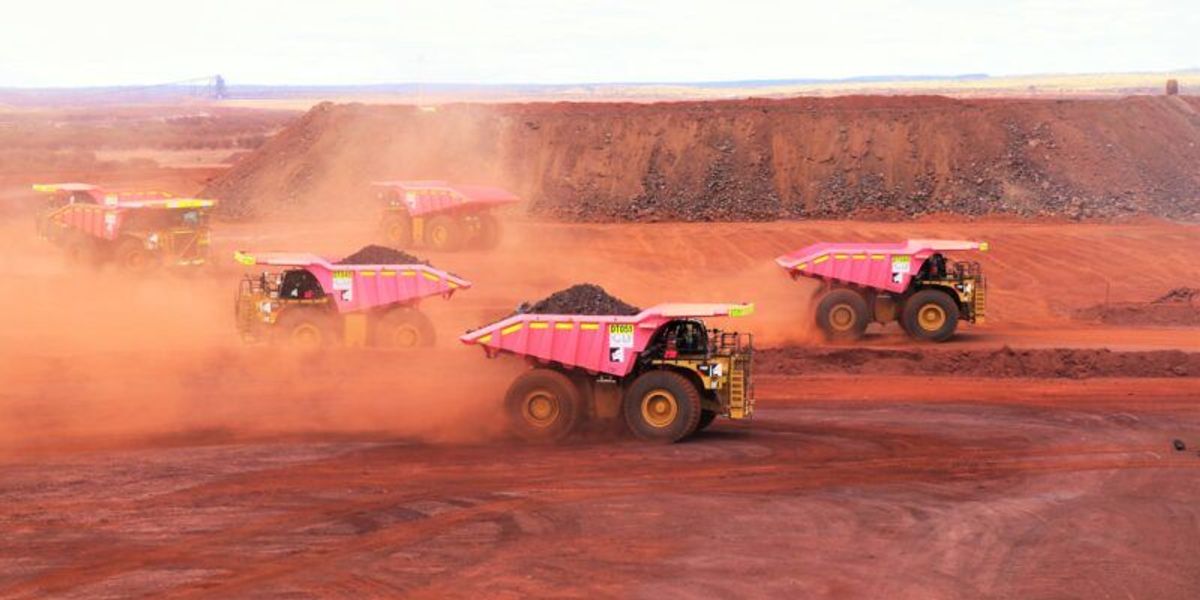
Vehicles hauling ore at Roy Hill iron ore mine.
Photo of Roy Hill iron ore mine via Roy Hill.
Hancock Prospecting’s Roy Hill and Hope Downs iron ore mines are in Western Australia's resource-rich Pilbara region.
Roy Hill has attracted strategic partnerships with major global enterprises: Marubeni (TSE:8002) has a 15 percent equity stake, POSCO Holdings (NYSE:PKX,KRX:005490) has a 12.5 percent stake and China Steel (TPE:2002) has a 2.5 percent stake. The minority partners purchase a combined 28.75 million tonnes of iron ore annually from Roy Hill’s production.
In September 2024, Hancock Prospecting got the green light for its AU$600 million McPhee iron mine located about 100 kilometres north of the Roy Hill mine after a long approval process.
The McPhee iron mine is expected to produce around 10 million tonnes of the metal each year over an estimated 15 year mine life. First production is expected to kick off next year, and ore will be transported by road trains to Roy Hill for processing and blending. The goal is to improve the larger mine's product mix and sustain its production volumes.
The Hope Downs iron ore complex is another of Australia’s largest iron ore projects. A 50/50 joint venture partnership with Rio Tinto (ASX:RIO,NYSE:RIO,LSE:RIO), Hope Downs hosts four open-pit mines and has an annual production capacity of 47 million tonnes. Hope Downs has also been the subject of a more than decade-long civil dispute in a Western Australian court over royalties, put forth by the descendants of Lang Hancock's business partner Peter Wright as well as Rinehart’s own children.
In June 2025, the partners announced a combined investment of US$1.6 billion to develop the Hope Downs 2 iron ore project, a part of the main JV. The project hosts the Hope Downs 2 and Bedded Hilltop deposits, which together will have a total annual production capacity of 31 million tonnes.
Gina Rinehart’s iron ore investments
Gina Rinehart’s iron ore investments in Western Australia extend beyond Roy Hill and Hill Downs to Atlas Iron’s three producing mines and a pipeline of development projects.
Rinehart’s Hancock Prospecting acquired Atlas Iron in 2018 through a AU$427 million deal that turned out to be dirt cheap as the company would go on to deliver AU$1.5 billion in revenues over the next three years alone.
Today, Atlas Mines operates the Mount Webber, Sanjiv Ridge and Miralga Creek mines. Production from these mines in its fiscal year ended June 2023 led to a AU$222 million dividend payment for Rinehart’s Hancock Prospecting.
As of July 1, 2025, Hancock Prospecting has consolidated its Roy Hill and Atlas Iron under the new name Hancock Iron Ore. The new entity represents combined iron ore exports of about 74 million tonnes per year.
Additionally, Hancock has an earn-in agreement on Legacy Iron Ore (ASX:LCY) and Hawthorn Resources’ (ASX:HAW) Mount Bevan project through its subsidiary Hancock Magnetite Holdings.
At Mount Bevan, as part of its earn-in agreement, Hancock completed a prefeasibility study (PFS) for a 12 million tonne per year high-grade magnetite project in July 2024. The PFS incorporates a resource estimate totalling 1,291 million tonnes, which was completed by Atlas, and delineates a capital cost of AU$5 billion to develop Mount Bevan.
Completion of the PFS increased Hancock’s stake in the joint venture from 30 percent to 51 percent, with Legacy now holding 29.4 percent and Hawthorn holding 19.6 percent.
Like iron, coal is another essential material in steel manufacturing. To this end, Rinehart is also pursuing an investment in a past-producing metallurgical coal mine in Alberta, Canada. Hancock Prospecting subsidiary Northback Holdings is the owner of the proposed Grassy Mountain steelmaking coal project in the province’s Crowsnest Pass region.
Exploration licences for the Northback project were greenlit by Alberta regulators in May 2025.
Gina Rinehart’s lithium investments
Gina Rinehart's lithium investments include Azure Minerals’ (ASX:AZS) Andover lithium project, Liontown Resources, Delta Lithium (ASX:DLI) and Vulcan Energy Resources (ASX:VUL).
The majority of her lithium investments came in a flurry in 2023 and 2024.
In June 2023, Rinehart’s Hancock Prospecting signed a separate joint venture earn-in agreement for the Mount Bevan magnetite project discussed above, this time for the lithium, nickel and copper mineralization at the project. The agreement will similarly see Hancock able to earn a 51 percent interest by completing certain milestones.
In September 2023, Rinehart made headlines when she took a position in Liontown Resources and then rapidly increased the position to 19.9 percent over the following month. This allowed Hancock, which was now Liontown's largest shareholder, to effectively block Albemarle’s (NYSE:ALB) accepted takeover of the smaller lithium company.
However, Liontown took a hit as the economics for its near-production Kathleen Valley lithium project in Western Australia were affected by high inflation and low lithium prices. In January 2024, Albemarle decided to sell off its 4 percent stake in Liontown. The lack of any further moves or comment by Rinehart in relation to Liontown Resources has led to speculation she may be waiting for the right opportunity to buy up the lithium company at a discount.
Kathleen Valley entered open-pit production in late July 2024, and is expected to produce approximately 500,000 tonnes per year of spodumene concentrate per year. In April of this year, the operation became Australia's first underground lithium mine when it commenced production from its Mount Mann deposit. Liontown plans to fully transition production to the underground mine in its fiscal 2026.
Albemarle's Liontown acquistion wasn't the only lithium bid Rinehart blocked in October 2023. As is her strategy, Rinehart scooped up an 18.9 percent stake in Azure Minerals after SQM announced its intention for a total takeover of the company and its Andover lithium project in the West Pilbara region of Western Australia.
This story had a different ending, though, as Hancock Prospecting instead joined the lithium giant in a AU$1.7 billion deal to become a co-owner of the exploration-stage Andover project. The deal closed in May 2024.
Shortly after its Liontown and Azure moves, Hancock Prospecting continued investing in Western Australia's lithium prospects when it participated in a AU$70.2 million fundraising for Delta Lithium in November 2023. The proceeds will help Delta Lithium to fund the development of its Mount Ida lithium-gold project, which is adjacent to Hancock's Mount Bevan joint venture project. As of November 2024, Hancock Prospecting owns 10.65 percent of Delta Lithium.
Rinehart has made lithium investments outside of Australia as well. Looking further afield to Germany, with a 7.5 percent stake, Hancock Prospecting is the second largest shareholder in Vulcan Energy and its flagship Zero Carbon lithium project in Germany’s Upper Rhine Valley, a milestone Rinehart's company reached after investing an additional AU$20 million in Vulcan, which made headlines in June 2024. The Zero Carbon project is slated to produce an initial 24,000 tonnes of lithium hydroxide by the end of 2025, targeting Europe’s electric vehicle manufacturing sector.
In November 2024, Vulcan Energy reached another major milestone with first production at its downstream lithium hydroxide optimisation plant, which is designed to produce lithium hydroxide and battery-grade lithium hydroxide monohydrate. In May 2025, Vulcan commenced drilling on its first new geothermal energy-lithium well in Landau, Germany, as part of its Phase 1 Lionheart project. The site currently holds four production and re-injection wells and the company aims to add 24 more that will produce hot lithium brine. Vulcan plans to use the new production to increase its geothermal energy production and begin commercial lithium production.
Gina Rinehart’s rare earth metals investments
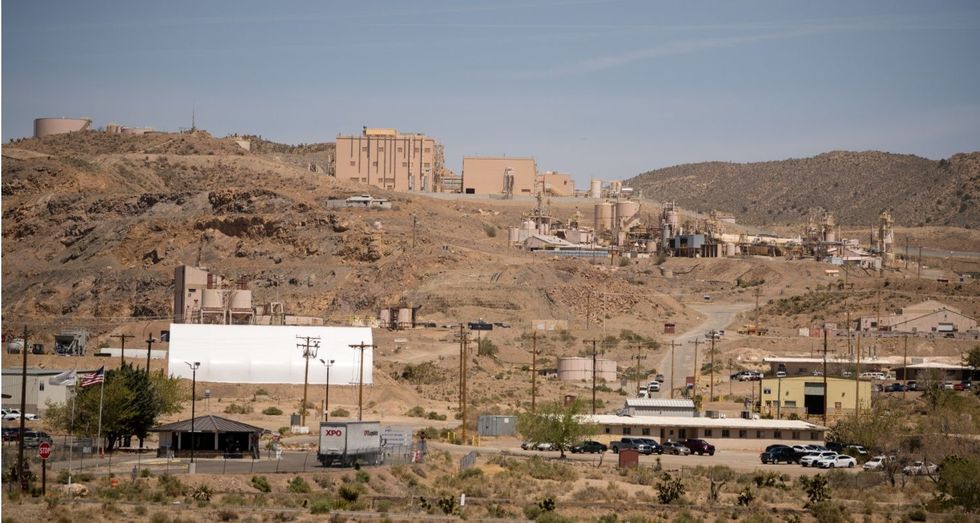
Facilities at MP Materials' Mountain Pass rare earths mine.
clayton harrison / Shutterstock
Through Hancock Prospecting, Gina Rinehart has made investments in some of the world’s most well known rare earth mineral producing companies — US-based MP Materials and Australia’s Lynas Rare Earths — as well as development-stage Arafura Rare Earths and exploration-stage Brazilian Rare Earths (ASX:BRE). Rinehart taking a position in these rare earths companies shows she is looking to capitalise on the significant need for these critical metals outside of China.
As mentioned in the introduction to this article, Rinehart’s Hancock Prospecting is the largest shareholder of Arafura Rare Earths, giving it a 10 percent stake in the advanced-stage Nolans project in the Northern Territory, Australia. Rinehart made the investment in December 2022.
In April 2024, Rinehart made two significant moves into the sector. The first came on April 9, when it was revealed that Hancock Prospecting had acquired a 5.3 percent stake in MP Materials, the second largest rare earths producer outside of China. The company’s California-based Mountain Pass mine is the only integrated rare earth mining and processing operation in North America.
Rinehart’s investment in MP Materials could later bring in “Roy Hill-type cash flow,” Dylan Kelly, head analyst at Terra Capital, told Australian Financial Review. “Anything that is producing and not China-aligned is highly strategic. These materials are very, very hard to make and there’s a lot of demand in making magnets for electric vehicles and wind turbines."
One week later, Rinehart’s Hancock Prospecting also took up a 5.82 percent interest in Lynas Rare Earths, the largest ex-China rare earths producer. The Australian rare earths miner produces the critical metals at its Mount Weld mine in Western Australia and ships the raw material to Malaysia for processing. Lynas is also ramping up processing at its Kalgoorlie rare earth processing facility in Australia, and building light rare earths processing facilities and a heavy rare earths separation facility in Texas, US.
Rinehart’s near simultaneous investments in both Lynas and MP Materials comes after merger talks between the two rare earths behemoths stalled in February 2024. There was speculation stirring that Rinehart’s participation could renew merger discussions, Reuters reported.
In November 2024, the mining mogul increased her position in MP Materials to 8.5 percent, further raising the possibility of a merger down the road. As for Lynas, she raised her stake to 7.14 percent in July 2024 and then 8.21 percent in January 2025.
Rinehart is also getting her foot in the rare earths door at the exploration level. In 2023, Rinehart’s Hancock Prospecting made a pre-IPO investment for a 5.85 percent share in Brazilian Rare Earths, which went on to list on the ASX in December of that year. The rare earth explorer is working its district-scale Rocha da Rocha rare earth asset in the state of Bahia, Brazil. The province is highly prospective for both heavy and light rare earths, with grades of over 40 percent total rare earth oxides found. Brazilian Rare Earths is working to complete an updated JORC mineral resource estimate.
Gina Rinehart’s copper investments
Gina Rinehart’s copper investments are centered on Ecuador’s Andean copper-gold belt, and include explorer Titan Minerals and Ecuador's state-owned Empresa Nacional Minera (ENAMI).
Ecuador has seen a rush of major mining companies taking up positions in key copper and gold projects in recent years, placing Hancock Prospecting in the company of Barrick Mining (TSX:ABX,NYSE:B), Zijin Mining (HKEX:2899) and Anglo American (LSE:AAL,OTCQX:AAUKF).
Rinehart’s Ecuadorian copper investments are in line with her shift toward the critical metals necessary for the green transition and her strategy to expand the global footprint of her mining empire.
Hancock Prospecting subsidiary Hanrine Ecuadorian Exploration and Mining has been in the region since 2017, and has continued to make more investments. In March 2024, Hancock Prospecting subsidiary Hanrine Ecuadorian Exploration and Mining acquired a 49 percent stake in six mining concessions for AU$186.4 million. The deal sees it partner with state mining company ENAMI for the concessions, which surround the stalled Llurimagua copper-molybdenum project in Northern Ecuador.
In late April 2024, Ecuador’s constitutional court nixed appeals by ENAMI and its partner in the Llurimagua project, Chile’s state-owned CODELCO, to review the March 2023 decision by Imbabura’s provincial supreme court suspending the environmental licence for Llurimagua.
Shortly after the investment with ENAMI, Rinehart's Hanrine made another play in Ecuador by striking an earn-in agreement with Titan Minerals for up to an 80 percent ownership stake in the explorer’s Linderos copper-gold project contingent on up to AU$120 million in exploration spending. Linderos is an early-exploration stage project with the potential to host a large-scale copper porphyry system. Hanrine has made an initial investment of AU$2 million for a 5 percent stake.
Gina Rinehart’s oil and gas investments
Gina Rinehart’s oil and gas investments include private firms Warrego Energy in Western Australia and Senex Energy in Queensland.
In February 2023, Hancock Prospecting won a protracted bidding war for the then-public Warrego with Warrego's joint venture partner Strike Energy (ASX:STX) at a price of AU$0.36 per share. Warrego and operator Strike Energy maintain their 50/50 joint venture on the West Erregulla onshore gas field within exploration permit EP 469 near Perth in Western Australia.
In mid-August 2024, the West Erregulla project received its production licence. During Phase 1, the project is expected to produce 87 terajoules per day.
As for Senex Energy, it is a joint venture between POSCO (50.1 percent) and Hancock Prospecting subsidiary Hancock Energy (49.9 percent) that holds the Atlas and Roma North natural gas developments in Queensland’s Surat Basin. The two JV partners acquired Senex in 2022, with Rinehart’s company putting up AU$440.89 million.
Senex Energy has embarked on a AU$1 billion expansion endeavor at Atlas and Roma North that will see 60 petajoules of natural gas delivered to Australia’s east coast market annually by the end of 2025. This figure represents more than 10 percent of the region’s demand. Regulatory approval for the expansion was finally received following an uphill battle with a Federal government more interested in renewable energy projects than the natural gas variety. Hancock Prospecting reported the first flows of gas production from the expansion field in late November 2024.
Rinehart once had a significant stake of nearly 20 percent in Lakes Oil, now Lakes Blue Energy (ASX:LKO), through subsidiary Timeview Enterprises. Timeview's stake in Lakes Blue Energy has been lowered in recent years, but it remains the company's fourth largest shareholder at 4.63 percent.
In late October 2024, Rinehart offered financial assistance to Mineral Resources (ASX:MIN,OTC Pink:MALRF), a diversified mining company with lithium, iron ore and oil and gas operations in Western Australia. Headed by another mining heavyweight, Chris Ellison, Mineral Resources (MinRes) is reportedly drowning in debt and embroiled in a tax evasion investigation. At that time, Hancock Prospecting agreed to a AU$1.13 billion buyout of MinRes' oil and gas projects in the Perth Basin and an exploration acreage in the Carnarvon Basin.
The 100 percent sale of two of MinRes' exploration permits to Hancock was completed in December 2024 for initial consideration of AU$780 million, with potential for up to AU$327 million depending on whether certain conditions and thresholds are met. The permits include the Moriarty Deep prospect and the Lockyer gas and Erregulla oil discoveries.
Separate to that sale, the two companies are also forming two 50/50 exploration joint ventures for MinRes' remaining permits in the Perth and Carnarvon Basins. Hancock will acquire 50 percent of the MinRes Explorer drill rig, which is the largest in Australia.
Gina Rinehart’s potash and agriculture investments
Gina Rinehart’s potash and agricultural investments center on Hancock Prospecting’s ownership interests in multiple premium cattle stations in Australia, and the company's royalty revenue generated from the Anglo-American-controlled Woodsmith potash project currently under construction in the United Kingdom.
With an original investment of AU$380.6 million in 2016 to then-owner Sirius Minerals, Hancock Prospecting has a 5 percent revenue royalty on the first 13 million tonnes of fertiliser produced from Woodsmith and 1 percent thereafter. Hancock also has a 20,000 tonne per year offtake option. The timeline for Rinehart’s royalty revenue has been pushed back, however, as Anglo is cutting spending at Woodsmith following BHP’s (ASX:BHP,NYSE:BHP,LSE:BHP) failed mega-merger with Anglo American.
Investor takeaway
With Gina Rinehart at the helm of Hancock Prospecting, the Roy Hill iron ore mine has generated stellar revenues.
That wealth creation not only made her Australia's richest person, but has also built a powerful war chest from which Rinehart is expanding her mining empire.
Investors can take cues from her recent and future moves in the mining sector. Although she may be defensive toward renewable energy technologies encroaching on agricultural land, she understands the strategical importance of investing in critical metals for the green transition such as lithium, rare earths and copper.
FAQs for Gina Rinehart
How much is Gina Rinehart worth?
Gina Rinehart's net worth is reported to be AU$38.11 billion, maintaining her spot as the richest Australian, according to figures from the Australian Financial Review's Rich List 2025. However, her total wealth is down 6 percent over the previous year.
"Iron ore magnate Rinehart has topped the Rich List for the sixth year in a row, but the falling iron ore price has hit the valuation of her Hancock Prospecting, wiping around $2b off her estimated net worth," the list's authors explain.
What company does Gina Rinehart own?
Gina Rinehart owns Hancock Prospecting, a private company founded by her late father Lang Hancock. Originally an iron ore mining company, today the firm has strategic stakes in a wide-range of metals and commodities from lithium and rare earths to copper and agriculture, which are detailed in this article.
Can I buy shares in Hancock Prospecting?
While investors can't buy public shares in privately held Hancock Prospecting, they can take equity positions in the publicly traded stocks in which the company itself holds interest. Some of these stocks include Arafura Rare Earths (ASX:ARU,OTC Pink:ARAFF), Liontown Resources (ASX:LTR,OTC Pink:LINRF), MP Materials (NYSE:MP) and Lynas Rare Earths (ASX:LYC).
Does Gina Rinehart own Rio Tinto?
Although she has interest in many mining companies and the two companies share the Hope Downs joint venture, Gina Rinehart does not own mining giant Rio Tinto. Market Screener reports that Aluminum Corporation of China (SHA:601600) is its largest shareholder at 14.5 percent, followed by BlackRock (NYSE:BLK) and others at around 3 percent and below.
What does Gina Rinehart think about nuclear energy?
Gina Rinehart is pro-nuclear energy. During a speech at The Australian Bush Summit in 2023, she railed against the impact of wind and solar farms on much needed agricultural land in Australia. She suggested that nuclear energy offers a more viable solution for reaching the country's net zero targets.
Is Gina Rinehart the richest person in Australia?
Gina Rinehart is the richest person in Australia with a net worth of AU$38.11 billion. In 2025, she topped the Australian Financial Review's Rich List for the sixth consecutive year in a row. The next richest Australian, real estate developer Harry Triguboff, trails her at AU$29.65 billion.
Is Gina Rinehart the richest woman in the world?
Gina Rinehart is not the richest woman in the world. While she did rank as the world's ninth richest woman in 2024, as of March 2025, she is no longer in the top ten. The distinction of richest woman in the world goes to Walmart (NYSE:WMT) heiress Alice Walton. Rinehart previously held the title in 2012.
This is an updated version of an article first published by the Investing News Network in 2024.
Don't forget to follow us @INN_Australia for real-time news updates!
Securities Disclosure: I, Melissa Pistilli, hold no direct investment interest in any company mentioned in this article.
Keep reading...Show less
Latest News

Sign up to get your FREE
Metals Australia Investor Kit
and hear about exciting investment opportunities.
- Corporate info
- Insights
- Growth strategies
- Upcoming projects
GET YOUR FREE INVESTOR KIT
Latest Press Releases
Related News
TOP STOCKS
American Battery4.030.24
Aion Therapeutic0.10-0.01
Cybin Corp2.140.00









